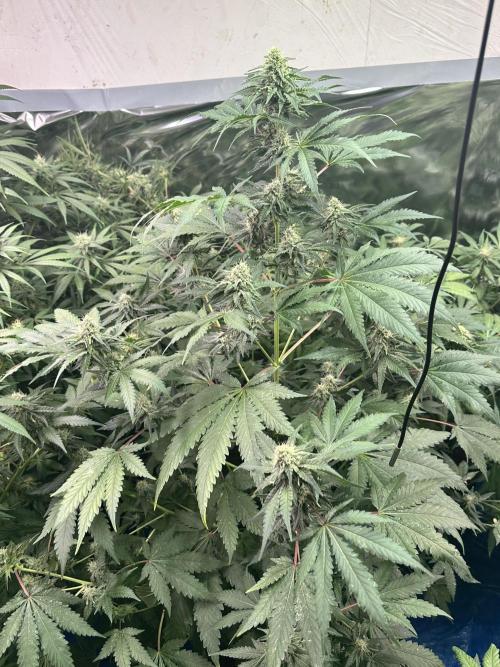The Grow Awards 2026 🏆 



























On lower leafs some brown patches started to appea...
dadrockisbestrockstarted grow question 6y ago
On lower leafs some brown patches started to appear and leafs are turning to a yellow color. Think is either Cal def by how it looks like or it is because of PH fluctuations as last week we changed our PH to 6.2 for 4-5 days and now it is back to 5.9 and under 24h spots appeared?
likes
Mrs_Larimaranswered grow question 6y ago
Hi, In the comments i will let you alink for growing in Coco coir. Picture nr3 looks to me as if you have spilled some solution onto the leaves. And yes I agree the other Picture looks like having troubles with the PH. And just one hint.. your coc never should run dry, all the other recommondations you can read on the site. Up to now no big damage is done. Just follow the tutorial on the site ... greetings
Grey_Wolfanswered grow question 6y ago
@dadrockisbestrock Yes it does look like a calcium issue and somtimes the bright light can make it worse. Youll need to do a mini flush with plain water then feed some calmag additive with the ph set at 6.2 leave it at 6.2 until it shows signs of recovery
likes
Complain
Master_weedaanswered grow question 6y ago
Hello my friend 😉
That's what you need to know about coconut fiber👍
Regarding watering, as explained above, the substrate being inert it will apply fertilizer at each watering, taking care to measure the pH and EC of the nutrient solution.👍
The EC or Electro Conductivity is the amount of fertilizer or mineral salts present in an aqueous solution, it will be adjusted according to the needs of the plants according to their stage of development. The pH is the measure used to define whether a water is basic or acidic, the pH scale is 0.0 to 14.0.
For the cultivation of coconut fiber it is advisable to maintain a pH between 5.5 and 6.3, depending on the phase of development of plants we will approach more than one value or the other. Generally the ideal PH in growth is 5.8, and 6.0 for the flowering, being able to slightly vary the PH so that all the different nutrients are assimilable by the plants.
Fertilizers must be adapted to this substrate, chelated fertilizers will be preferred because of their high absorption by plants, more efficient and fast. There are many manufacturers who create fertilizers specifically for coconut, which offers a wide choice of increasingly refined product lines specialized in this type of hydroponics.
Mineral fertilizers are the most used, being products specially studied for hydroponics. Note the appearance of organic ranges studied for coconut cultivation, opening up new possibilities for growers accustomed to the strong scent of plants grown in the soil with organic fertilizers.
Containers or pots for coconut substrate cultivation should always have a good drainage system, so that excess water can easily be drained, leaving the substrate moist but also oxygenated, in order to favor assimilation of nutrients, but also to avoid exposing the roots to the risk of rot and other diseases.
We will also emphasize that we will need a smaller amount of substrate and therefore smaller pots, for a development comparable to that of a plant grown in soil. The equivalence Coco VS Terre would be 1.65 L of coconut for 7 liters of soil, for larger plants, pots of 3 liters of coconut will be used instead of 11 liters of soil.
The watering of coconut plants will begin in a manner similar to that of earthen plants, although it may be noted that coco has characteristics superior to the earth in drainage and evaporation of moisture in the soil. substrate, because of its high level of oxygenation.👍
Thus watering at the beginning of the growth period will be done manually, not exceeding 100 ml per plant, to facilitate humidification and rapid drying of the substrate, to alternate cycles of moisture and drought that will allow the system root to develop optimally and wholesome, protecting it from diseases. As the plants grow, the amount of watering will increase. From the second week of flowering we can install an automatic watering system and maintain a regular and constant nutrition to improve production.
Good luck for your grow 🌱
May the force be with you💪
1 like
Complain
Similar Grow Questions
Solved

Desmo
Planten krijgen bladeren met plekken,iemand enig idee wat het probleem is?Wat is hier mis aan het lopen?
Steeds meer bladeren die plekken krijgen en ik die niet begrijp of weet waarom.Had de raad gekregen calmag bij te geven maar dat lijkt niet te verbeteren daarmee.Onderkant blad is mooi groen,bovenkant steeltje paars en plekken op de bladeren?
Leaves. Color - Mottling
5y ago
1
2
Solved

Tjcashmoney
Rust spots on leavesCheck the pics and recommend something to help a newbie out. I’ve seen it for a couple weeks. I removed all leaves with necrosis, but it came back. I don’t know for certain what it is. I think it might be a calcium deficiency. I was going to go out and get some gypsum, but I want
Week 7
Leaves. Color - Mottling
4y ago
2
3
Solved

Scooby_Doo
Plants deteriorating rapidly, pls helpPlants not looking good! Help!
White tips at the end. Brown patches. Leaves curling.
I've been feeding it 0.5L Advanced Nutrients Coco Big Buds.
The light was fairly close, at 30cm. I've raised the lights to 60cm.
It was also very humid, so I've opened the air vents .
Leaves. Curl up
Leaves. Color - Yellow
Leaves. Color - Mottling
4y ago
3
Solved

T3rMiNaToR3
Splotches on leaves and green soil tingeWhat do I do about this? Splotches on three leaves total, two different fans, soil has green tinge.
Week 3
Leaves. Color - Mottling
5y ago
4
4
Solved

Chr0nus
Spotted leavesPlant seems to be flowering ok but there are white spots on the leaves. What could it be. I also have a fruit fly problem.
Leaves. Color - Mottling
3mo ago
1
2
Solved

bbkaldo
Is it a Cal-mag deficiency? From total newbie point of view.I really need help with these dots on leaves - any ideas, pros, masters, exp. amateurs, anyone?
I had no problems just till today on 2 out of 4 trees. (only low humidity in germination, but they lived through)
Photos taken few hours ago, and now it is like 50% more of it. WTH?😓
2y ago
2
1
Solved

crusoe
Lime green mottling on leavesHi,
Still seeing mottled green on leaves, more visible on the first set. She appears to be growing well but I'm eager to understand whats causing the green mottling so I can head off any problems. I've been comparing with various leaf issues but struggling to find a match?
Week 2
Leaves. Color - Mottling
5y ago
1
1
Solved

VacaVerde
Hi there.I’m almost sure it’s a female (pic). I got my first bugs. By the look of it I guess it’s spider mites. What I did so far is spray top and bottom leafs with a neen oil solution after lights out and since I saw it on only 2 of the bottom leafs (removed). Any other tip?Week 12
Leaves. Color - Mottling
7y ago
2
2
Solved

Toastdtoast
Still K deficiency?I fed some flower fuel to plant 1, half strength, and the discoloration got worse! Some leaves almost look like cal deficiency so I also sprayed foliar with calmag, just now when I got home. Is this still looking like a K deficiency? If so, should I feed it again or wait?
Week 9
Leaves. Color - Mottling
4y ago
4
3
Solved

Fitzwell
Think I need to add more cal-mag might be turning into a cal-mag whore? We will see....Week 10
Leaves. Color - Mottling
6y ago
6
5
Solved

Weisasss
Cal/mag def. Or nute burn?I think I've got a Cal/Mag deficiency going on....or burn....not sure. Rust colored spots developing on leaves between veins. My pics labeled today, 11/9, show the progress. I don't think I'm overfeeding and growth is still progressing. Can anyone confirm?
Week 9
Leaves. Color - Mottling
4y ago
3
3
Solved

WeedVV
Leaves spotsHi guys, yesterday these leaves suddenly look like this, is it a serious problem? How can I solve it
Leaves. Color - Mottling
5y ago
3
3
Solved

DrDank22
What might be going on with her? In Ocean Forest soil just water so far no nutes.Week 4
Leaves. Color - Mottling
7y ago
2
6
Solved

Iamthejazz123
MottlingFrom the moment the first leaves started growing they've had this weird mottling. Only environmental prob is my temps occasionally hit 84f, mostly it's around 78f. Every leaf grows in like this. I had 1 other plant do this, turned out mostly male herm from a fem seed.
Leaves. Color - Mottling
6y ago
1
3
Solved

Mr_Prawn
Novato con manchas en hojas DWCEn cuarta semana de floración empezaron a salir manchas a las plantas, es cultivo DWC, no se si es problema de deficit o exceso de Calmag u otra cosa, soy un poco novato.
Alguien me puede ayudar a identificar el problema?
Ph aprox 6 abonos GHE tripart.
Muchas gracias
Week 8
Leaves. Color - Mottling
5y ago
4
1
Solved

Cheeba_Inu
One of my seedlings, seedling A, is twisting a bit as it grows and has some small lighter patches on a few of it's leaves. The other seedling is growing in the same conditions but very normal in it's growth. Any idea if this is a genetic variation, or an environmental issue?Week 2
Leaves. Color - Mottling
7y ago
4










